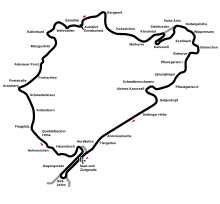
Back جائزة ألمانيا الكبرى 1953 Arabic 1953 Голяма награда на Германия Bulgarian Gran Premi d'Alemanya del 1953 Catalan Grand Prix Německa 1953 Czech Großer Preis von Deutschland 1953 German Anexo:Gran Premio de Alemania de 1953 Spanish جایزه بزرگ آلمان ۱۹۵۳ Persian Saksan Grand Prix 1953 Finnish Grand Prix automobile d'Allemagne 1953 French Gran Premio de Alemaña de 1953 Galician
| 1953 German Grand Prix | |||||
|---|---|---|---|---|---|
| |||||
 Nürburgring layout | |||||
| Race details | |||||
| Date | 2 August 1953 | ||||
| Official name | XVI Großer Preis von Deutschland | ||||
| Location | Nürburgring, Nürburg, West Germany | ||||
| Course | Permanent road course | ||||
| Course length | 22.810 km (14.173 miles) | ||||
| Distance | 18 laps, 410.580 km (255.123 miles) | ||||
| Weather | Sunny, mild, dry | ||||
| Pole position | |||||
| Driver | Ferrari | ||||
| Time | 9:59.8 | ||||
| Fastest lap | |||||
| Driver |
| Ferrari | |||
| Time | 9:56.0 on lap 12 | ||||
| Podium | |||||
| First | Ferrari | ||||
| Second | Maserati | ||||
| Third | Ferrari | ||||
|
Lap leaders | |||||
The 1953 German Grand Prix was a Formula Two motor racing event held on 2 August 1953 at the Nürburgring Nordschleife. It was race 7 of 9 in the 1953 World Championship of Drivers, which was run to Formula Two rules in 1952 and 1953, rather than the Formula One regulations normally used. This race had the highest number of cars on the grid of any World Drivers' Championship race, with 34 starters.[1]
This race was won by Nino Farina in a Ferrari, just over 1 minute ahead of Juan Manuel Fangio. This was Farina's last victory in Formula One.
Ferrari driver Alberto Ascari clinched his second consecutive World Drivers' Championship as neither Mike Hawthorn nor Juan Manuel Fangio won the race and now couldn't beat his points total with two races left.
Four East German drivers partook in this race; these four drivers were the only ever drivers to race under an East German licence. This race was the last time any driver competed under an East German licence: Theo Fitzau, Ernst Klodwig and Rudolf Krause would never race in Formula One again, while Edgar Barth would race again under a West German licence.
During his tour of Europe that saw Japan's 19-year old Crown Prince Akihito visit the Coronation of Queen Elizabeth II, he also attended the German Grand Prix.[2]
- ^ "All time Formula One records". f1technical.net. Retrieved 4 August 2015.
- ^ Födisch, Jörg Thomas; Völker, Bernhard; Behrndt, Michael (2008). Der große Preis von Deutschland. Alle Rennen seit 1926. Königswinter: HEEL Verlag. p. 69. ISBN 9783868520439.
